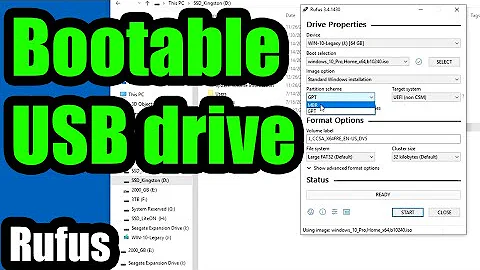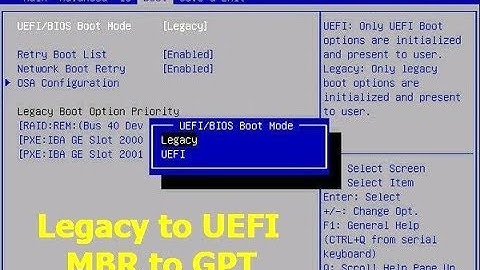How do I convert my usb installation from legacy boot to uefi?
If a live or persistent live system
@C.S.Cameron's comments are relevant.
-
Save the casper-rw file or the content of the casper-rw partition.
-
The method he is describing is explained with more details at the following link,
-
If you want a persistent live system with a casper-rw partition, you can use mkusb to create it from the same Ubuntu iso file as the previous one. Then the content of the old casper-rw partition will work.
If an installed system (installed like into an internal drive)
It is possible to convert the boot mode from BIOS (alias legacy) mode to UEFI according to this link (as suggested by @MichaelBay in the comment to your question),
An alternative (for other users, who read this in the future) is to create an installed system (or modify your current system) such that it can boot both in UEFI mode and BIOS mode. See the following link,
help.ubuntu.com/community/Installation/UEFI-and-BIOS
This way you make a system, that is portable between newer and older computers.
Related videos on Youtube
Ben Sakac
Updated on September 18, 2022Comments
-
Ben Sakac over 1 year
I installed elementary os onto a usb using legacy settings, and I can boot it using legacy bios options. However, I would like to switch the boot to UEFI so that I dont have to change my PC's firmware setting everytime I want to boot windows from my hard drive, or switch it again when I want to boot elementary off the USB. Is this possible, and how would I go about doing it?
-
 Meninx - メネンックス over 6 yearsWhat kind of install is on the USB? Live, Persistent or Full install? If you are using a Persistent install, you can save your casper-rw file to your windows desktop, do a UEFI install and replace the casper-rw file when done. You may need to add the word "persistent" to your boot configuration.
Meninx - メネンックス over 6 yearsWhat kind of install is on the USB? Live, Persistent or Full install? If you are using a Persistent install, you can save your casper-rw file to your windows desktop, do a UEFI install and replace the casper-rw file when done. You may need to add the word "persistent" to your boot configuration. -
 Meninx - メネンックス over 6 yearsNot sure what this question has to do with the "duplicated" question, which concerned switching the internal drive to UEFI, this question concerns getting a USB drive to boot UEFI.
Meninx - メネンックス over 6 yearsNot sure what this question has to do with the "duplicated" question, which concerned switching the internal drive to UEFI, this question concerns getting a USB drive to boot UEFI. -
 Meninx - メネンックス over 6 yearsFor a UEFI only USB device you can simply extract the Ubuntu ISO to the FAT32 formatted USB device using 7Zip and set the boot flag. Add your casper-rw file and the word "persistent" before "quiet splash" in /boot/grub/grub.cfg.
Meninx - メネンックス over 6 yearsFor a UEFI only USB device you can simply extract the Ubuntu ISO to the FAT32 formatted USB device using 7Zip and set the boot flag. Add your casper-rw file and the word "persistent" before "quiet splash" in /boot/grub/grub.cfg. -
 sudodus over 6 yearsBen Sakac, are you asking about an installed system (installed like into an internal drive, but into a USB drive) or about a live or persistent live system)? -- If a live or persistent live system, @C.S.Cameron's comments are relevant, and marking it 'duplicate' is wrong.
sudodus over 6 yearsBen Sakac, are you asking about an installed system (installed like into an internal drive, but into a USB drive) or about a live or persistent live system)? -- If a live or persistent live system, @C.S.Cameron's comments are relevant, and marking it 'duplicate' is wrong. -
Ben Sakac over 6 years@sudodus it is an installed system, but it is installed on a usb as opposed to an internal drive
-
Marecky over 4 years+1 to encurage more contribution from OP
-
-
 Meninx - メネンックス over 6 yearsIt does not sound like the op needs BIOS mode, only to boot the USB in UEFI mode, so he does not need to adjust the computer each boot.
Meninx - メネンックス over 6 yearsIt does not sound like the op needs BIOS mode, only to boot the USB in UEFI mode, so he does not need to adjust the computer each boot. -
 sudodus over 6 years@C.S.Cameron, You are right. I was thinking about other users, who might benefit from the alternative. But it can be misunderstood. After a short time (enough to let you read this) I will remove this answer.
sudodus over 6 years@C.S.Cameron, You are right. I was thinking about other users, who might benefit from the alternative. But it can be misunderstood. After a short time (enough to let you read this) I will remove this answer. -
 Meninx - メネンックス over 6 yearsThanks Sudodus, I'm wondering how this question got marked as duplicate? I think this would be the perfect question to propose The Simple Method.
Meninx - メネンックス over 6 yearsThanks Sudodus, I'm wondering how this question got marked as duplicate? I think this would be the perfect question to propose The Simple Method. -
 sudodus over 6 yearsUntil we know better, I edited my answer to add a paragraph (if the original question is about live and persistent live system).
sudodus over 6 yearsUntil we know better, I edited my answer to add a paragraph (if the original question is about live and persistent live system). -
Ben Sakac over 6 years@sudodus I have an installed system on 32 GB pendrive. What you describe, modifying my system to be able to boot in BIOS and in UEFI sounds like what I want, but the link you provide for that seems to be for creating an install in this way, not modifying a current system to be able to boot in both modes?
-
 sudodus over 6 years@BenSakac, 1. What about the accepted answer to this question at AskUbuntu: askubuntu.com/questions/509423/… ? 2. I agree about the other link: help.ubuntu.com/community/Installation/UEFI-and-BIOS , it is for creating an install in this way. But you can pick up some tips from there about how to [remove grub-pc and] install grub-efi, which can install a bootloader for UEFI mode without losing the abililty to boot in BIOS mode, if that is what you want.
sudodus over 6 years@BenSakac, 1. What about the accepted answer to this question at AskUbuntu: askubuntu.com/questions/509423/… ? 2. I agree about the other link: help.ubuntu.com/community/Installation/UEFI-and-BIOS , it is for creating an install in this way. But you can pick up some tips from there about how to [remove grub-pc and] install grub-efi, which can install a bootloader for UEFI mode without losing the abililty to boot in BIOS mode, if that is what you want. -
Ben Sakac over 6 years@sudodus I am just not sure what I am supposed to be booting from as my system is installed on a pendrive. Should I boot a live uefi usb with the system usb just plugged in? Also, I partitioned the whole drive for the installation, so is it possible to shrink it in order to create the seperate partition for the bootloader without disturbing the system?
-
 sudodus over 6 years1. It depends on which computers, that you expect to boot from the USB drive. If only computers running in UEFI mode, or only computers running in BIOS mode or both; 2. You can shrink a partition (move the tail end of the partition to create drive space for the ESP (EFI system partition) or bios_grub partition or both, depending on what you need. You can try, but remember that it is risky to edit partitions. You can make a cloned copy before starting.
sudodus over 6 years1. It depends on which computers, that you expect to boot from the USB drive. If only computers running in UEFI mode, or only computers running in BIOS mode or both; 2. You can shrink a partition (move the tail end of the partition to create drive space for the ESP (EFI system partition) or bios_grub partition or both, depending on what you need. You can try, but remember that it is risky to edit partitions. You can make a cloned copy before starting. -
 sudodus over 6 yearsIt might be easier to start from the beginning from a compressed image file from help.ubuntu.com/community/Installation/UEFI-and-BIOS, and install the program packages (maybe a meta package like
sudodus over 6 yearsIt might be easier to start from the beginning from a compressed image file from help.ubuntu.com/community/Installation/UEFI-and-BIOS, and install the program packages (maybe a meta package likelubuntu-desktoporxubuntu-desktopto get the corresponding flavour of Ubuntu, orubuntu-desktopto get standard Ubuntu).


![Convert LEGACY Bios to UEFI Windows 10 Without Data Loss | Without Reinstalling Windows [2021]](https://i.ytimg.com/vi/t8Hklaw92IM/hq720.jpg?sqp=-oaymwEXCNAFEJQDSFryq4qpAwkIARUAAIhCGAE=&rs=AOn4CLDD6l3A-wBv_JZinbVGFLBmrWxQ9g)

